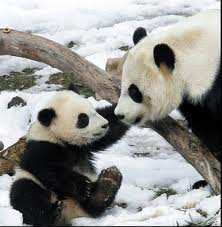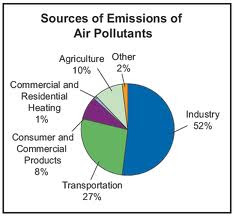1. Population Explosion
Whether we like to admit it or not, our very own rapidly multiplying presence on this planet is the biggest environmental problem there is, and it’s getting bigger by the minute. We voraciously consume resources, pollute the air and water, tear down natural habitats, introduce species into areas where they don’t belong and destroy ecosystems to the point of causing millions of species to become endangered and, all too often, go extinct.
It took nearly all of human history – from the first days of man on earth until the early 1800’s – to reach a global population of 1 billion. In just 200 years, we’ve managed to reach 6.5 billion. That means the population has grown more since 1950 than in the previous four million years. We’re adding roughly 74 million people to the planet every year, a scary figure that will probably continue to increase. All of those mouths will need to be fed. All of those bodies will need clean water and a place to sleep. All of the new communities created to house those people will continue to encroach upon the natural world.
All seven environmental problems detailed above are very serious, and we’ve got to start treating them that way. We may not have easy solutions, but the fact is, we simply can’t continue living our lives as if everything is peachy. These problems aren’t going to magically solve themselves. We should have begun acting generations ago, but we can’t go back in time, and that means we have to step up our efforts. If we want to keep this planet a healthy place for humans to live – for our grandchildren to enjoy – it’s time to buckle down and do everything in our power to reverse the damage we’ve done.
2. CO2 Levels in the Atmosphere
The aforementioned polar sea ice loss is yet another sinister sign of carbon dioxide levels building up in the atmosphere – the main force behind global warming. Greenhouse gas emissions caused by our modern way of life – vehicles, power plants, factories, giant livestock farms – will bring devastating climate change within decades if they stay at today’s levels.
Average temperatures could increase by as much as 12 degrees Fahrenheit by the end of the century if emissions continue to rise, a figure that would easily make the world virtually uninhabitable for humans. A global temperature rise of just 7.2 degrees Fahrenheit would cause a catastrophic domino effect, bringing weather extremes that would result in food and water shortages and destructive floods.
The most recent report by the Intergovernmental Panel on Climate Change represents “the final nail in the coffin” of climate change denial, representing the most authoritative picture to date that global warming is caused by human activity. According to the panel, we must make a swift and significant switch to clean, efficient and renewable energy technologies in order to prevent the worst-case scenario.
3. Polar Sea Ice Loss
Polar sea ice is melting at an unprecedented rate, and it’s not showing any signs of slowing down. It’s perhaps the most dramatic, startling visual evidence of global warming, and it’s got scientists rushing to figure out just how big of an effect the melting is going to have on the rest of the world.
British researchers said last week that the thickness of sea ice in the Arctic decreased dramatically last winter for the first time since records began in the early 1990s. The research showed a significant loss in thickness on the northern ice cap after the record loss of ice during the summer of 2007.
Scientific American warns that “human fingerprints have been detected” on both the Arctic and Antarctic regions. Antarctica had previously appeared to be the only continent on the planet where humanity’s impact on climate change hadn’t been observed. The collapse of the Larsen B and Wilkins ice shelves in the Antarctic Peninsula shows just how fast the region is warming.
4. Destruction of the Rain Forest
‘Saving the rain forest’ has been at the forefront of the environmental movement for decades, yet here we are facing huge losses in the Amazon all the same. You might have thought that, with all the attention the rain forest has gotten, it wouldn’t need so much saving anymore – but unfortunately, global warming and deforestation mean that half of the Amazon rain forest will likely be destroyed or severely damaged by 2030.
The World Wildlife Fund concluded this summer that agriculture, drought, fire, logging and livestock ranching will cause major damage to 55 percent of the Amazon rain forest in the next 22 years. Another 4 percent will see damage due to reduced rainfall, courtesy of global warming. These factors will destroy up to 80 percent of the rain forest’s wildlife. Losing 60 percent of the rain forest would accelerate global warming and affect rainfall in places as far away as India. Massive destruction to the rain forest would have a domino effect on the rest of the world.
The WWF says that the ‘point of no return’, from which recovery will be impossible, is only 15 to 25 years away.
5. Collapsing Fish Stock
Millions of people across the world depend upon fish as a major staple in their diet. As such, commercial fishermen have been pulling such a huge quantity of fish from the oceans that we’re heading toward a global collapse of all species currently fished – possibly as soon as the year 2048. Like large-scale mammal extinction, the collapse of fish species would have a major impact on the world’s ecosystems.
It’s not too late – yet – if overfishing and other threats to fish populations are reduced as soon as possible. Marine systems are still biologically diverse, but catastrophic loss of fish species is close at hand. 29 percent of species have been fished so heavily or have been so affected by pollution that they’re down to 10 percent of their previous population levels. If we continue the way we are fishing today, there will be a 100 percent collapse by mid-century, so we’ve got to turn this around fast.
6. The Ocean Dead Zones
In oceans around the world, there are eerie areas that are devoid of nearly all life. These ‘dead zones’ are characterized by a lack of oxygen, and they’re caused by excess nitrogen from farm fertilizers, emissions from vehicles and factories, and sewage. The number of dead zones has been growing fast – since the 1960’s, the number of dead zones has doubled every 10 years. They range in size from under a square mile to 45,000 square miles, and the most infamous one of all is in the Gulf of Mexico, a product of toxic sludge that flows down the Mississippi from farms in the Midwest. These ‘hypoxic’ zones now cover an area roughly the size of Oregon.
Spanish researches recently found that many species die off at oxygen levels well above the current definition of ‘uninhabitable’, suggesting that the extent of dead zones in coastal areas that support fishing is much worse than previously thought. Robert Diaz, a Virginia Institute of Marine Science biologist, said “Everything is pointing towards a more desperate situation in all aquatic systems, freshwater and marine. That’s pretty clear. People should be worried, all over the world.”
As if that weren’t bad enough, global warming will likely aggravate the problem. A rise in carbon dioxide in the atmosphere will change rainfall patterns, which could create an increase in runoff from rivers into the seas in many areas.
7. Mammal Extinction
7. Mammal Extinction
One in four mammals is threatened with extinction. That’s 25%, a huge number that will totally change the ecology of every corner of the earth. We could see thousands of species die out in our lifetime, and the rate of habitat loss and hunting in crucial areas like Southeast Asia, Central Africa and Central and South America is growing so rapidly, these animals barely have a chance.
If you think the extinction of an animal like the beautiful Iberian Lynx is no big deal, and wouldn’t have that much of an effect on the planet, think again. Not only would we be losing – mostly due to our own disregard for our surroundings – so much of the awe-inspiring diversity of nature, mass extinctions like this would cause a serious imbalance in the world’s food chain. When a predator disappears, the prey will multiply. When prey dies out, the predator will see its ranks decrease as well. Many people fail to realize just how interconnected all species on this planet really are.
If you think the extinction of an animal like the beautiful Iberian Lynx is no big deal, and wouldn’t have that much of an effect on the planet, think again. Not only would we be losing – mostly due to our own disregard for our surroundings – so much of the awe-inspiring diversity of nature, mass extinctions like this would cause a serious imbalance in the world’s food chain. When a predator disappears, the prey will multiply. When prey dies out, the predator will see its ranks decrease as well. Many people fail to realize just how interconnected all species on this planet really are.
























